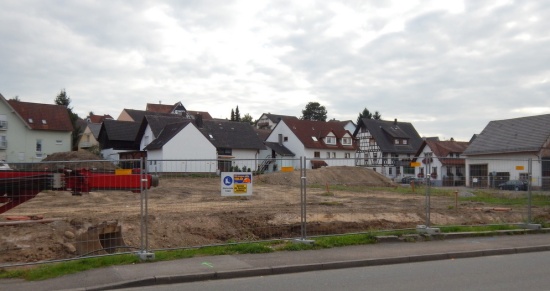Vicki and I recently enjoyed the hospitality of friends in Friesenheim, a village of 7,000 people set in the wine hills of southwest Germany near the French border.
 Our hosts Alexander and Ingeborg live in the house that Ingeborg’s father built, where I first visited them in 1975. Friesenheim’s central area has hardly changed since those days, and the village council apparently sees this as a problem. The council has approved a controversial development plan for the main street — to make it more like Kitsilano, let’s say, or Burnaby Heights — with a four-story mixed-use complex, apartments upstairs, commercial space at grade, across from the 400-year-old municipal hall.
Our hosts Alexander and Ingeborg live in the house that Ingeborg’s father built, where I first visited them in 1975. Friesenheim’s central area has hardly changed since those days, and the village council apparently sees this as a problem. The council has approved a controversial development plan for the main street — to make it more like Kitsilano, let’s say, or Burnaby Heights — with a four-story mixed-use complex, apartments upstairs, commercial space at grade, across from the 400-year-old municipal hall.
On Saturday morning, Alexander and I walked from Friesenheim to the town of Lahr, about five kilometres away. We watched a large-scale harvesting machine at work in the vineyards, doing work that would traditionally have taken dozens of farm workers. As we approached Lahr, Alex recalled some of the complicated history of this country, which was divided for centuries into hundreds of small territories governed by princes, bishops, lords and merchant committees. A different kind of fragmentation is heard in the range of dialects and sub-dialects. Folks who grew up in Lahr speak differently from those in Friesenheim, said Alex — “the music of the sentences is different” — although with television and migration, these distinctions are breaking down in favour of a single standard form of speech.
We met our wives (and Vicki’s mom) at a cafe in the Lahr market square. The local merchants were launching an autumn sales week with a farmers market and outdoor music, and we spent a pleasant hour touring the central area on foot.
I lived in Lahr for two years in the 1970s, as a civilian employee at the Canadian Armed Forces radio station, and I was struck by the changes that have taken place. The central area has been re-created as a pedestrian zone, and is quieter, safer and visually much improved. The range of services is excellent and the businesses seem to be doing well, helped no doubt by the absence of large indoor shopping malls for miles around. In a town roughly the same size as Courtenay, Port Coquitlam, Medicine Hat or Brandon — and granted, with the benefit of an ancient layout — Lahr offers an extensive area of pedestrian interest and retail vitality.
For the generation after 1945, many of the old streets in Europe were opened up to motor vehicles wherever they would fit. But many cities and towns have turned away from this notion since 1980, as we saw in a three-week, three-country tour. Heavy restrictions on central-area traffic are now routine.
Rather than driving away business, this shift appears to make central-area property more attractive for both commercial and residential purposes. We heard frequent complaints, in fact, that apartment purchase prices in the old town centres are becoming unaffordable, as they are for many people in central Vancouver. As I was drafting this entry, I came across more evidence of this trend in a post on the Atlantic magazine’s City Lab site.






